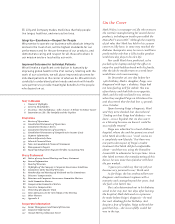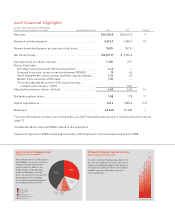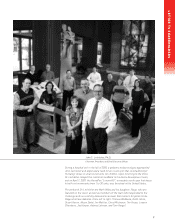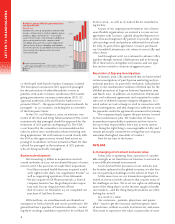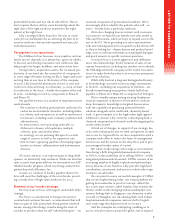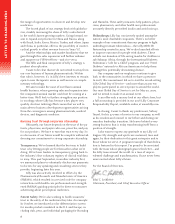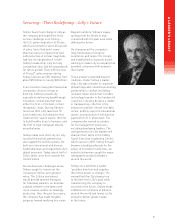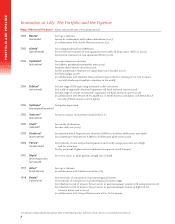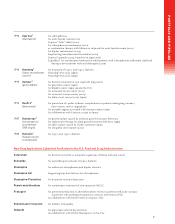Eli Lilly 2008 Annual Report Download - page 9
Download and view the complete annual report
Please find page 9 of the 2008 Eli Lilly annual report below. You can navigate through the pages in the report by either clicking on the pages listed below, or by using the keyword search tool below to find specific information within the annual report.
A LEADER’S LEGACY
7
Securing—Then Redefi ning—Lilly’s Future
Sidney Taurel took charge of Lilly as
the company anticipated the most
serious challenge in its history—
the U.S. patent expiration of Prozac,
which accounted for some 25 percent
of sales. Up to that point, every
pharmaceutical company that had
suffered a loss of similar magnitude
had lost its independence. Under
Sidney’s leadership, Lilly not only
survived but also laid the groundwork
for future growth. Even with the loss
of Prozac®, sales revenue during
Sidney’s tenure as CEO doubled, from
about $10 billion to nearly $20 billion.
In an era when many pharmaceutical
companies chose to merge or
diversify, Sidney focused Lilly
squarely on delivering breakthrough
innovation—medicines that were
either the fi rst, or the best, in their
therapeutic class. During Sidney’s
tenure as CEO, Lilly launched 10
such medicines, including the fi rst
treatment for severe sepsis, the fi rst
to build healthy bone in humans, and
the fi rst to treat malignant pleural
mesothelioma.
Sidney made sure that Lilly not only
touched the world’s patients but
also tapped the world’s talents. He
built an international and diverse
leadership team and expanded Lilly’s
global presence. Today, about half of
Lilly’s sales come from outside the
United States.
As new business challenges arose,
Sidney sought to transform the
company to deliver even greater
value. The Lilly he envisioned
would provide tailored therapies
for individual patients, orchestrate
a global network to be faster and
more creative, and be increasingly
productive. Over the past four years,
the company has made tangible
progress toward realizing this vision.
Beyond numbers, Sidney’s legacy
springs from his ability to stay
connected with the past even while
defi ning the future.
He championed the company’s
long-held values of integrity,
excellence, and respect for people
and established a corporate brand,
working to make Lilly a company that
provided customers with answers
that matter.
Those answers extended beyond
medicine. Under Sidney’s leader-
ship, Lilly was a leader in corporate
philanthropy and created a pioneering
partnership to combat multidrug-
resistant tuberculosis that includes
technology transfer to the hardest-hit
countries. Lilly also became a leader
in transparency—the fi rst in the
industry to publish clinical trial data
online, publicly report its educational
grants, and announce it will disclose
payments to U.S. physicians. The
company also earned accolades
for its management practices—
including developing leaders. The
next generation of Lilly leaders will
sharpen their skills in the Sidney
Taurel Executive Leadership Center,
which opens in 2009. Sidney himself
became a leading advocate for the
power of innovative medicines—an
industry statesman sought by major
newspapers and policymakers
around the world.
Sidney once said that a leader
“provides direction and supplies
the motive power to change.” He
exemplifi ed that. By staying true
to the best from Lilly’s past while
transforming the company to
succeed in the future, Sidney made
a difference to millions of patients
around the world and leaves a Lilly
poised to deliver greater value
in the future.


